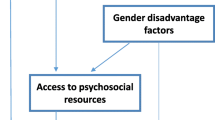Abstract
There are 47.22 million homeless and runaway adolescents roaming on the streets of our country (Voluntary Health Association of India — VHAI) of which one lakh are in Delhi. Very little is known about them, their needs or their experiences.Objective: (1) To assess the psychological problems amongst the runaway adolescent boys. (2) To determine possible risk factors.Methods: This study was cross-sectional in design and done at a child observation home for boys in Delhi. All runaway boys aged 10 to 16 years of age were included in the study. The study was conducted from 15th June to 15th July 2001. A comprehensive schedule consisting of five parts, viz identification data, hopelessness scale for children by Kazdin, Beck depression inventory, Psychological survey questionnaire and RUTTER-B2 scale were used to assess various mental health problems.Results: 20.7% of children were found to have high hopelessness and 8% of children had depression. 2% of children revealed that they had attempted suicide at any point of time in life. Among children with high hopelessness, 3.2% had ever attempted suicide. 8.3% of the depressed children gave history of suicidal attempts. 38% of children gave history of physical abuse, 14.6% of sexual abuse and a large number reported substance abuse. 69.33% were found to have behavioral problems (i.e. scored above the recommended cut off score of 9). 81% of children had antisocial behavior, 7.8% were neurotic and 10.5% remained undifferentiated.Conclusion: Runaway adolescents suffer from a wide array of mental health problems and there is a need for a broad based psychosocial intervention programme.
Similar content being viewed by others
References
Bose AB. Street children: A growing urban phenomenon. In Amodh Kanth, RM Verma, eds.Neglected Child, 1st edn. Delhi, Rawat Publications, 1993; 217–227.
Council on scientific affairs. Health care needs of homeless and runaway youth.JAMA 1989; 262: 1358–1361.
Shaffer D, Caton CLM. Runaway and homeless youth in New York City: A report to the Litteson foundation. New York, NY: Division of Child Psychiatry. New York State Psychiatric Institute and Colombia, University College of physicians and Surgeons, 1984.
Bemporad, JR, Wilson A. A developmental approach to depression in childhood and adolescence.Journal of the American Academy of Psychoanalysis 1978;6: 325–352.
Rye HE. Depression in childhood: A survey of some pertinent contributions.Journal of the American Academy of Child Psychiatry 1966;5: 653–685.
Kazdin AE, Antoinette R, Debra C. The hopelessness scale for children: Psychometric characteristics and concurrent validity.Journal of Consulting and Clinical Psychology 1986; 54(2): 241–245.
Barrera M Jr, Garrison-Jones CV. Properties of the Beck Depression Inventory as a screening instrument for adolescent depression.J Abnorm Child Psychol 1988; 16(3): 263–273
Rutter MA. Children’s behavior questionnaire for completion by teachers: Preliminary findings.Child Psychiatry 1967; 8: 1–11.
Segal UA, Ashtekar A. Detection of intrafamilial child abuse. Children at intake at a child observation home in India.Child Abuse Negl 1994; 18(11): 957–67.
Janus M, Burgess A, McCormack A. Histories of sexual abuse in adolescent male runaways.Adolescence 1987; 22: 405–417.
Kurtz P, Kurtz G, Jarvis S. Problems of maltreated runaway youth.Adolescence 1991; 26: 544–555.
Kufeldt K, Nimmo M. Youth on the street: abuse and neglect in the eighties.Child Abuse Negl 1987; 11: 531–543.
Greene JM, Ennett ST, Ringwalt CL. Substance use among runaway homeless youth in three National samples.Am J Public Health 1997; 87: 229–235.
Hersch P. Coming of age on city streets.Psychol Today 1988; 28–37.
Singh TB. Epidemiological study of mental health problems among handicapped school children. Brief research report.Int J Rehab Research 1988; 11(4): 379–382.
Amrey J, Tomkins A, Victor C. The prevalence of behavioral problems amongst homeless primary school children in an outer London borough: a feasibility study.Public Health 1995; 109: 421–424.
Kolvin I, Garside RF, Nicol AR, Leitch I, Macmillan A. Screening school children for high risk of emotional and educational disorder.Brit J Psych 1977; 131: 192–206.
Malhotra S, Arun P, Kohli A. Applicability of Rutter-B scale on Indian population.Indian J Psych 2000; 42(1): 66–72.
Farber E, Mcload D, Kinast C. Violence in families of adolescent runaways.Child Abuse Negl 1984; 8: 295–299.
Author information
Authors and Affiliations
Rights and permissions
About this article
Cite this article
Khurana, S., Sharma, N., Jena, S. et al. Mental health status of runaway adolescents. Indian J Pediatr 71, 405–409 (2004). https://doi.org/10.1007/BF02725627
Issue Date:
DOI: https://doi.org/10.1007/BF02725627



